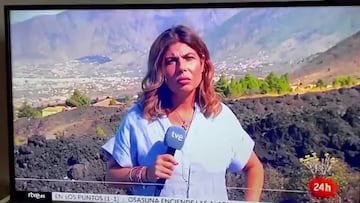Can the volcano in La Palma produce a tsunami at the east coast of United States?
The Volcanological Institute of the Canary Islands and geologists of the ING responded to the theory being put forward about the risk to other coastlines.

Just hours after the Spanish island of La Palma rumbled and the volcano erupted, a theory about its wider repercussions began to gain strength, again. And despite the fact that the authorities, professionals, the Instituto Vulcanológico de Canarias and geologists from the National Geographical Institute deny it, the aftershocks of these claims continue to be felt.
**Follow the evolution of the Cumbre Vieja de La Palma volcano live**
The theory I'm talking about surrounds the question: Could a tsunami be created from the landslide collapse that would hit the east coast of the United States?
No, is the simple answer, based on most research. The answer was the same in 2017 and it seems that it is necessary to confirm it once again in 2021.

Based on the current geometry of the island, the geological structure, the inclination of the layers, etc., Cumbre Vieja would be stable enough according to the geo-mechanical models and stability analysis undertaken. For it to happen otherwise, a very high magnitude earthquake would have to occur simultaneously along with an eruption with a high explosive index. Or, the current volcano would have to reach, in its natural growth, more than a thousand metres above its current maximum elevation," something that was explained in 2017.
Cumbre Vieja Volcano: the tsunami theory
Steven Ward, a professor at the Institute of Geophysics and Planetary Physics at the University of California, and Simon Day, of the Benfield Greig Hazard Research Centre, University of London, published the 2001 research into the Cumbre Vieja Volcano and a potential collapse and tsunami at La Palma.
“Geological evidence suggests that in a future eruption, the Cumbre Vieja volcano on the island of La Palma could experience a catastrophic break on its western flank, throwing between 150 and 500 cubic kilometers of rock into the sea.”
Collapses have happened in the Canary Islands, but they are very very rare, and the tsunami threat is local. The "mega tsunami" story for the whole Atlantic has been thoroughly debunked (for instance, https://t.co/qRt1Hs01PV).
— USGS Volcanoes🌋 (@USGSVolcanoes) September 19, 2021
According to the theory, if the island were to split in two, it would create a wall of water that would reach the coast of Portugal and southwestern Spain, which both lie to the north east. The waves could be up to 25 meters high, and would even cause damage to the south of England further north and then to the west they would reach the North American coast, as well as "destroy the West African coast with waves of up to 100 meters," according to the research.
The counter view to US tsunami threat from La Palma
This view, however, has been pretty strongly countered, so you can go to your bed sleeping easy if in one of those predicted risk areas. As an example, Dave Petley, the Pro-Vice-Chancellor (Research and Innovation) at the University of Sheffield in the United Kingdom, specialising in landslides, says.
“La Palma has undergone a previous flank collapse event, and there have been similar collapses elsewhere in the Canary Islands. Interestingly, none of these appear to have generated widespread tsunami deposits around the Atlantic basin.
“The key to the idea such an event developing again is the events of the major eruption in 1949. During this event, a fault structure was observed to develop along a part of the Cumbre Vieja ridge. This has been interpreted as indicating movement of the flank of the volcano towards the west, and thus the development of a potential flank collapse landslide on the southern part of La Palma.
An eruption at La Palma has begun. For official information follow this account below. Be extra diligent with misinformation & rumors. Eruptions impact lives & the wrong information causes harm.
— Dr Janine Krippner (@janinekrippner) September 19, 2021
A fissure eruption with lava fountaining and lava flows: https://t.co/iQM4ikGv7B
“I spent a day up on Cumbre Vieja, with the main aim of taking a look at this fault scarp. Armed with a map from one of the key papers I roamed up and down the mountains on a most beautiful day. The feature that I found is remarkably unremarkable in landslide terms. Based upon the maps, the most obvious feature that I could find is the scarp.
Related stories
“I have to admit that I struggle to believe that this feature is a key component of the mega-landslide hypothesis given its small size, but I could not find any more convincing alternative. Perhaps I missed the correct feature. The scarp suggests limited movement on the landslide, even if it is a correct interpretation, suggesting in turn that an actual failure would be unlikely in the foreseeable future.”
You can read Petley's full report including photos and diagrams.

